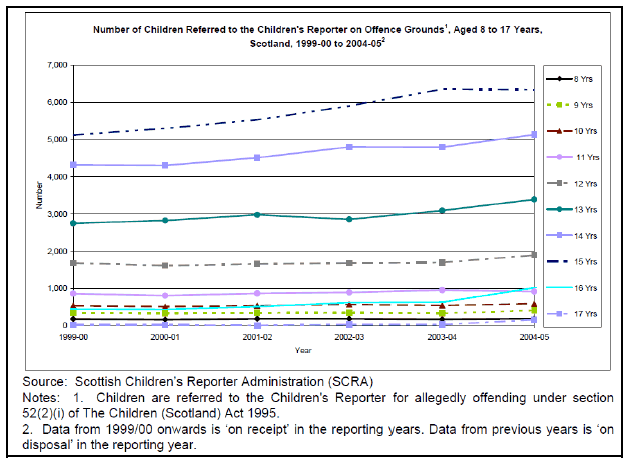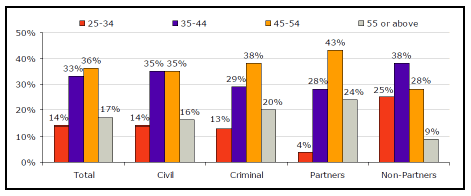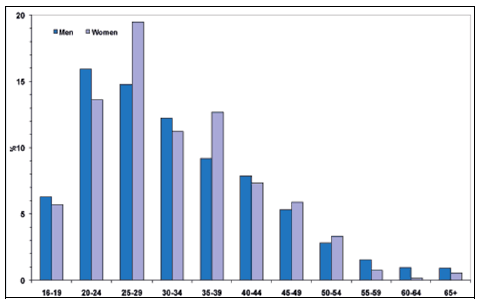Scottish Government Equality Outcomes: Age Evidence Review
This evidence review was prepared to support the production of the Scottish Government's Equality Outcomes, with regard to age.
9 Justice
9.1 This section looks at older and younger people's experience of crime, civil and criminal law, prison, domestic abuse, fires, perceptions of criminal justice, and the prison population.
Experience of crime
9.2 The Scottish Crime and Justice Survey 2010-11[122] estimates that around one in six (approximately 18%) adults aged 16 or over was the victim of at least one crime. The risk of being a victim of any crime decreased with age: 26% of 16-24 year olds were victims of crime compared with 9% of those aged 60 or older. The risk of being a victim of violent crime also decreased with age: 7% for 16-24 year olds compared with 1% of those aged 60 or over.
9.3 The Scottish Crime and Justice Survey reports that 27% of adults had experienced at least one civil law problem in the last three years, including:
- 16% of adults had experienced problems with home, family or living arrangements;
- 12% had experienced problems with money, finance or things they had paid for.
Civil and criminal law
9.4 The most common civil law problem was with neighbours (11% had experienced) followed by problems with faulty goods or services (6%). People aged over 60 are less likely to have experienced civil legal problems in the last three years than those in other age brackets (13% of those aged over 60, compared to 30% of those aged 16-24, 37% of those aged 25-44, and 29% of those aged 45-59). In addition those aged over 60 tend to suffer fewer numbers of problems: an average 1.29 problems compared to 1.78 for those aged 16-24, 1.76 for those aged 25-44, and 1.62 for those aged 45-59. Across all types of civil assistance[123] in 2010-11 the most common age groups seeking assistance lie between the late 20's through to the early 40's (most commonly 27 to 31 years).
9.5 The peak rates of convictions for males in 2010-11[124] were in the age range 18-20, at approximately 110 per 1,000 population. This compares to a rate of 47 per 1,000 population for all males. For women, the peak rates for convictions in 2010-11 were between 26 - 30, at approximately 19 per 1,000 population, around double the rate for all females.
9.6 In terms of Criminal Justice Social Work, Social Enquiry Reports were most common amongst young adults, accounting for 260 per 10,000 population of 18 to 20 year olds in 2010-11[125]. This is around three times the overall rate of 86 per 10,000 population.
9.7 The High-level summary of equality statistics[126] plots youth crime by the age of the offender (see Figure 11). Offence referrals to the Children's Reporter are most likely to occur for children aged 15 years. Since 1999-00, offence referrals have increased for all children aged between 8 and 17 years, with the largest increase being for children aged 15 (up 24%), followed by those aged 13 years (up 23%). It should be noted that the number of young people aged 16 or 17 years who are referred is relatively small. This is because most offenders in this age group are dealt with by the adult Criminal Justice System[ix].

Workforce
9.8 Figure 12 shows evidence on the age distribution of the workforce reported in a survey of legal aid solicitors in Scotland[127].
Figure 12: Age by main case type and by job role (Source: Solicitor Survey, 2010)

Prison population
9.9 The age profile of female prisoners tends to be somewhat older than that for men, as shown in Figure 13 below[128]:
Figure 13: Age distribution of prisoners by gender: 30 June 2010 (Source: Prison Statistics Scotland, 2010-11)

Domestic abuse
9.10 In 2009-10, the highest rates of incidents of domestic abuse per 100,000 population among female victims was for those aged between 19 and 30, where the rate was around 4,500 incidents per 100,000 population compared to a rate of around 1,600 for all female victims[129]. Among male victims, the highest rate of incidents of domestic abuse per 100,000 population in 2009-10 was for those aged 31 to 35 years, where the rate was 865 incidents per 100,000 population, compared to a rate of around 350 for all male victims. In 2009-10, the highest rate of incidents of domestic abuse per 100,000 population among female perpetrators was by those aged 19 to 21 years, where the rate was 928 incidents per 100,000 population, compared to an overall rate of around 320 for female perpetrators. Among male perpetrators, the highest rate of incidents of domestic abuse per 100,000 population was by those aged between 22 and 35, where the rate was over 4,000 incidents per 100,000 population, compared to an overall rate of around 1,700 for male perpetrators.
Fires
9.11 The provisional fire casualty statistics for 2010-11[130] show that there were 47 fatal casualties, with 21 in the 30-59 year age group and 20 for those aged over 60. The rate of fatal casualties was 16.6 per million population in the over 60 age group, compared to 9.9 per million for those aged 30 to 59.
Contact
Email: Social Research
There is a problem
Thanks for your feedback